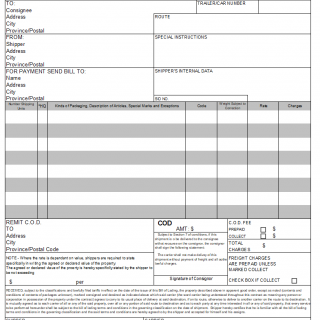Inland Bill of Lading
An inland bill of lading is a legal document that serves as proof of the transportation of goods within a single country, typically by truck or rail. It is a type of bill of lading that is used for domestic shipments, as opposed to international shipments that require an ocean bill of lading.
The inland bill of lading consists of several parts, including the name and address of the shipper and consignee, a description of the goods being transported, the origin and destination of the goods, the carrier's name and contact information, and the terms and conditions of the shipment. It may also include information about any special handling requirements or instructions for the carrier.
This form is typically drawn up when goods are being transported domestically within a single country, such as from one city to another. The parties involved in an inland bill of lading include the shipper, who is the person or company sending the goods, and the carrier, who is responsible for transporting the goods to their destination. The consignee, who is the person or company receiving the goods, may also be involved in the process.
When compiling an inland bill of lading, it is important to ensure that all of the necessary information is included and that it is accurate. This includes verifying the description of the goods being transported, the origin and destination of the shipment, and any special handling requirements or instructions. Inaccurate or incomplete information can lead to delays or other problems with the shipment.
Real cases of using this form include the transportation of goods for businesses and individuals within a single country, such as the shipment of products from a manufacturer to a retailer. In some cases, an inland bill of lading may be used in conjunction with other shipping documents, such as a commercial invoice or packing list.
The advantages of using an inland bill of lading include providing a clear record of the shipment and its contents, as well as establishing the terms and conditions of the shipment. This can be useful for resolving disputes or addressing any issues that may arise during the transportation process. However, if the form is filled out incorrectly or inaccurately, it can lead to delays, disputes, or even legal issues. It is important to carefully review and verify all of the information included in the form before submitting it to ensure that it is accurate and complete.

